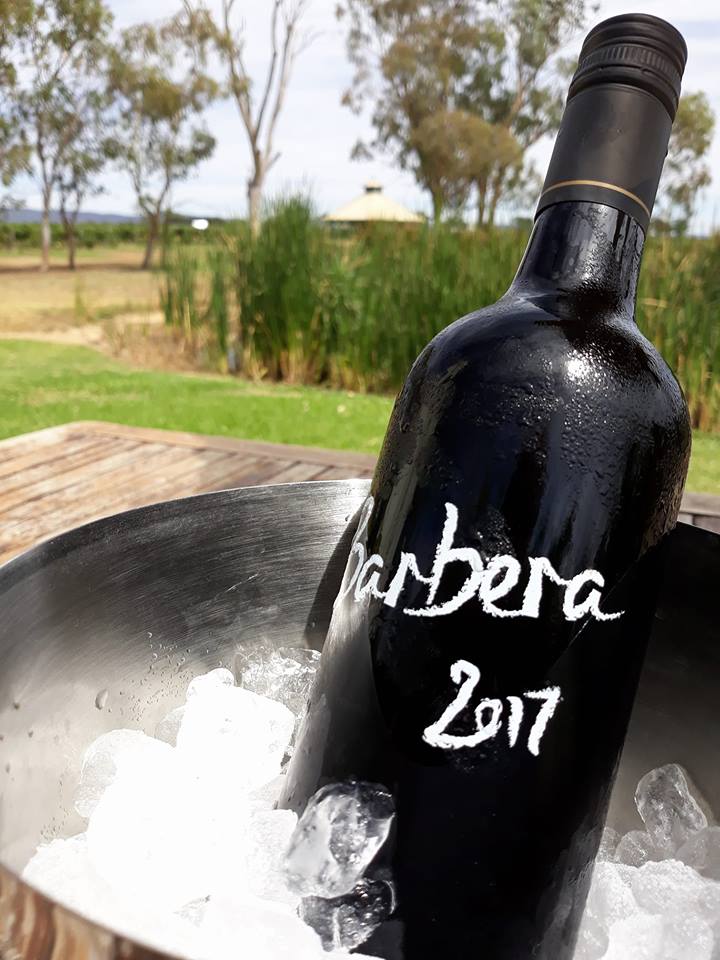Our Blog
Fantastic Figs!
Figs in one form or another have been on the planet for at least eighty million years.
Of course, its easy to stick around if there are more than 900 different species of you, which there are... But botanists have ascribed their longevity more to their characteristics than their range of varieties. To botanists, the winning factors are their universally beautiful taste, combined with their ‘accessibility’. No tough skin, for example.
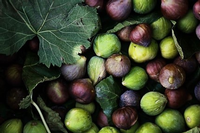
Figs attract the widest range of seed transporting animals in the whole of the plant kingdom. They are ecological linchpins, sustaining more wild birds and mammals than any other fruit tree on earth.
Figs are also the source of more myths and legends than any other fruit (or, more botanically correctly, a ‘false or multiple fruit', as the flowers and seeds grow together to form one gorgeous single ‘mass’).
Figs at di Lusso
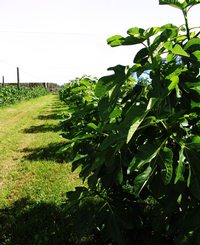 We grow five varieties of common fig at di Lusso Estate. All are female parthenocarpic varieties, and do not need pollination to produce fruit. So no need to deal with those little propagating wasps! Every year since 2003, my girls have performed the same ritual.
We grow five varieties of common fig at di Lusso Estate. All are female parthenocarpic varieties, and do not need pollination to produce fruit. So no need to deal with those little propagating wasps! Every year since 2003, my girls have performed the same ritual.
First, a showing of Black Genoa ripeness tells me it’s the second week of February.
A week later, it’s the turn of the White Adriatics (my favourite flavour, if I’m pushed to name one) to come to ripeness, with a more sustained season of six weeks or so. Meanwhile, my two lesser varieties Preston Prolific and Excel start moving.
Back comes Black Genoa with another season, then the mind-boggling champion of the orchard and juggernaut - Brown Turkey.
This lovely, patient variety is last to move, but more than makes up for this with a massive crop of around 1500 figs a tree that grows to the very top of the fig enclosure (or more than four metres). It is primarily the brown Turkey that keeps producing until the first frosts of May.
di Lusso Fig Products
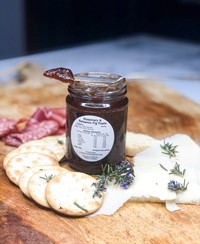
Steve Pavich, the Estate’s fig man, is out there almost every day, picking up to two thousand figs a day; sorting the crop between cellar door stock and crushed figs for ‘product’.
Product then moves under the control of Marcus Platt (one of several genii I’m blessed with at di Lusso) and who delivers a half dozen different flavours of fig pastes and vinaigrette (amongst much more farm produce) to the farmhouse door for our visitors.
And while all this is happening, the resident di Lusso spiders are ensuring the quality of the crop. I have never had to spray the figs in nearly twenty years, thanks to our golden orb weaver army that descends onto the trees as soon as the annual fig gnat plague begins early February.

These magnificent spider-hunters grow from 5 mm (.2 of an inch) to 5 cm (2 inches) in a season – and end up comprised entirely of exactly what I don’t want to find on the crop. (The only disconcerting feature is their habit of building their nets across the inter-rows of the orchard; meaning that driving the ride-on mower becomes a very interesting, and gastronomic experience!
Robert
2020... The year that was.
It didn't start well, did it?
Travelling to Mudgee town for my morning coffee and Sydney Morning Herald in thickening smoke from the first day of the New Year, I consoled myself with the twin thoughts that ‘the fires’ were still a hundred or more kilometres away and surely unlikely to damage the grape crop from that far off, and secondly we were off the mid-March for our annual trip to Europe. Earlier than usual, just in case the rumours of a dangerous virus from China was heading our way later in the year...
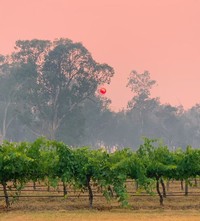 Well, we all know what happened. Sneaking out of France a day before all flights were cancelled – thanks to Qatar Airways, after Qantas and others had abandoned us! Straight back into reports that the 2020 grape crop was almost certainly non-existent (we had already lost the 2020 olive harvest due to huge hot winds in November that had literally burnt to death every flower in the grove), entire ‘lock down’ of di Lusso Estate’s commerce, and nobody willing or able to venture a guess as to when things might open up again.
Well, we all know what happened. Sneaking out of France a day before all flights were cancelled – thanks to Qatar Airways, after Qantas and others had abandoned us! Straight back into reports that the 2020 grape crop was almost certainly non-existent (we had already lost the 2020 olive harvest due to huge hot winds in November that had literally burnt to death every flower in the grove), entire ‘lock down’ of di Lusso Estate’s commerce, and nobody willing or able to venture a guess as to when things might open up again.
As I write, thanks mostly to our ‘lockable’ borders and judicious crisis management were still in the game – and thanks to the people of New South Wales for discovering in hordes the vineyards of Mudgee, we finished the rest of the year in good shape. Apart from a shortage of wine to sell at cellar door – due not to our tanks being empty, but rather to the very extended supply lines from interstate of bottles, printing ink, mobile bottling facilities etc, we were in business still. And now I can report that, thanks (I’m using that word a lot lately!) to hard work from the team, our shelves are full again!.

We bottled 2019 Pinot Grigio and 2020 Arneis this week (along with a Rosso version of Sangiovese, the excellent 2019 Nebbiolo and Lagrein), the last of the 2016 il Palio blend– for release next week.
Our new Vivo! bubbles arrived from the Hunter last week, too. So, dear Members, di Lusso Estate stands ready to once again be able to offer a ‘Full Portfolio’ (just the Aleatico is missing, and we currently working at filling that gap with a limited range of earlier vintage Aleatico).

Our plan at this stage is to let the new arrivals overcome any initial ‘bottle shock’ they may have, and to offer a Summer Members’ Special sometime in January. In the meantime, the newly bottled wines are ‘in stock’. I’d just suggest waiting a week or two before opening one up!
I’m sure you’ll join me in bidding the ‘challenging’ 2020 farewell, and here’s hoping for a more settled 2021.
'Buon Natale'
An Ode to Olives
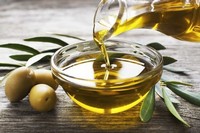 Way back in time, on a visit to Rome, Luanne and I wandered through the ancient ruins of the Roman Forum. It was late summer. The grass was flattened and yellow, tourists everywhere. Only three plants were to be seen… an old grape vine, a bedraggled fig tree, and an olive tree with just a couple of olives hanging from it.
Way back in time, on a visit to Rome, Luanne and I wandered through the ancient ruins of the Roman Forum. It was late summer. The grass was flattened and yellow, tourists everywhere. Only three plants were to be seen… an old grape vine, a bedraggled fig tree, and an olive tree with just a couple of olives hanging from it.
It was 1998, and Luanne and I had been considering our options in starting a new venture in Italian varietal wine. Then it hit us! Italian varietal wine, olive oil and figs. Three unmistakably Italian products, all from one tree (symbolically, the farm), and all well suited to Mudgee’s central west tableland.
In the years since then, di Lusso Estate’s wine and fig offerings have forged ahead of olives in dollars and effort and di Lusso olives don’t have much of a profile.
However, in the ‘bigger picture’ of world history, olives are arguably ahead of both wine and figs. This much loved tree, feature of countless biblical and historical stories has been around as possibly the world’s oldest commercially grown plant for 5,000 years at least.
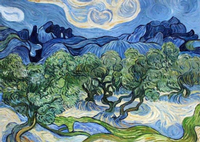 Olive trees and olive groves have been a favourite subject for some of the greatest artists. From the Renaissance painters of the 15th century to the contemporary painters, olives are depicted in various styles and forms, each a tribute to the magic of this tree.
Olive trees and olive groves have been a favourite subject for some of the greatest artists. From the Renaissance painters of the 15th century to the contemporary painters, olives are depicted in various styles and forms, each a tribute to the magic of this tree.
I remember, at one time during the early days of di Lusso, I collected fifteen prints of van Gogh’s olive paintings and hung them around the winery. The obsession faded, and the prints can’t be found. I’m sorry about that, but I can at least quote one of van Gogh’s many thoughts on the subject.
“The effect of daylight and the sky means there are endless subjects to be found in olive trees. For myself I look for the contrasting effects in the foliage, which changes with the tones of the sky. At times, when the tree bares its pale blossoms and big blue flies, emerald fruit beetles and cicadas in great numbers fly about, everything is immersed in pure blue. Then, as the bronzer foliage takes on more mature tones, the sky is radiant and streaked with green and orange, and then again, further into autumn, the leaves take on violet tones something of the colour of a ripe fig, and this violet effect manifests itself most fully with the contrast of the large, whitening sun within its pale halo of light lemon.”
Van Gogh is right, of course. The colours of an olive tree are extraordinary… at times khaki, at others almost emerald. Sometimes the tree is washed in grey.
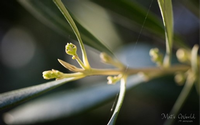
And the fruit is similarly deceptive. Just when you think there’s nothing there, you can suddenly see a myriad of what look like peppercorns, well-camouflaged. These are the emerging olive flowers.
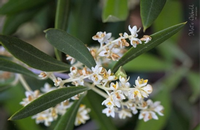
A week or so later – around mid-November – the canopy explodes in a white cloud of beautiful flowers. This is the time that we pray for windless days, to allow the fruit to set.
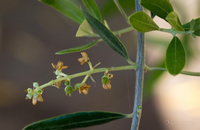
But in 2019, the same winds that drove the bush fire smoke towards Mudgee blew through our olive grove as well. And that was that! Flowers shriveled and burnt - practically no crop in 2020.
That’s farming!
But there are commercial risks on top of climatic ones. Most stem from mislabeling. Commercially, there are three different grades of olive oil made and marketed, around the world, from the high-quality extra-virgin olive oil (EVOO) to medium-quality ordinary virgin olive oil, to low-quality olive-pomace oil (OPO).
EVOO is obtained by direct pressing or centrifugation of the olives. Its acidity can be no greater than 1 percent; if it is processed when the temperature of the olives is below 30°C - it is called cold-pressed. (Cold-pressing olives adds density of flavour and texture.)
Olive oils with between 1 and 3 percent acidity are known as "ordinary virgin" oils, but anything with greater than 3 percent acid and refined is " by accepted chemical solvents”, can also be fairly marketed as "ordinary." The dry or pulpy residue of the olive pressing process is called pomace, from which a liquid (such as juice or oil) has been pressed or extracted.
In Australia, all the supermarket chains seem to turn a blind eye to the mislabeling of ordinary virgin olive oil – in terms of country of origin (for example it is said that many Spanish olive oils are marketed as Italian) and many oils with more than 3% of acid are marketed as EVOO. But perhaps the most common adulterants in mis-labelled virgin olive oils are refined olive oil containing synthetic oil-glycerol products, seed oils (such as sunflower, soy, maize, and grapeseed), and nut oils (such as peanut or hazelnut).
So, if you’re interested in tasting the best, refer to a source such as Choice to decide which supermarket oils are ‘honest’ and put the list in your pocket when going shopping!
Rob
Vintage Reflections
Hi Everyone,
End of the vintage leads one to reflect on the wine of the current and previous seasons. Thinking about winemaking, here’s a little secret …. the best wines make themselves. Yes… that’s right… an excellent wine is one where a winemaker does just the “standard winemaking,” and the result is fantastic. “Great vintages begin in the vineyard”, it’s excellent fruit that makes winemaking easy.
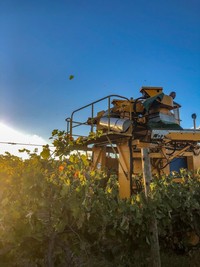 For example, the 2018 vintage was very easy… A long summer, followed by a warm, dry autumn resulted in excellent fruit across the vineyard. And if you’re a lover of Mudgee wines, you’ll be happy to know that the whole region experienced above average levels of quality… but at the cost of a significant drop in yield (which is generally a good thing!). Our favourites wines that year were the Lagrein and the Arneis 2019 was undoubtedly a season of drought, with a dry summer following a dry winter. We took advantage of our very good irrigation setup to replicate a ‘normal’ European winter with weekly waterings through winter, so that during the hot summer the vineyard’s resistance to drought both below ground and in the canopy was higher. Like its predecessor, the 2019 outcome was high fruit quality but with a bigger crop.
For example, the 2018 vintage was very easy… A long summer, followed by a warm, dry autumn resulted in excellent fruit across the vineyard. And if you’re a lover of Mudgee wines, you’ll be happy to know that the whole region experienced above average levels of quality… but at the cost of a significant drop in yield (which is generally a good thing!). Our favourites wines that year were the Lagrein and the Arneis 2019 was undoubtedly a season of drought, with a dry summer following a dry winter. We took advantage of our very good irrigation setup to replicate a ‘normal’ European winter with weekly waterings through winter, so that during the hot summer the vineyard’s resistance to drought both below ground and in the canopy was higher. Like its predecessor, the 2019 outcome was high fruit quality but with a bigger crop.
Of the 2019 wines, at this stage (bearing in mind not all have been bottled), I particularly like the Sangiovese and the Barbera (including our first ever sparkling Barbera which we call Vivace! The 2019 Nebbiolo sits closely behind. Then along came the 2020 vintage. Were we tested? Yes! Firstly, the third year of drought brought a quite small and inconsistent – and late – flowering and fruit set. So late was fruit-set that the fires that began seriously in September and which brought a pall of smoke that hung over New South Wales for some months from October caused few problems for us. (But the same could not be said for many other growers, particularly those to the east of the town; or for unirrigated organic growers, whose fruit tends to flower earlier). Despite more sampling and tasting than ever before, we could find no fault in either the Arneis or the Vermentino were excellent. Then, a few weeks later, our early-picked Sangiovese (for Vino Rosato) checked out really well.
The 2020 reds required very careful handling. We were very away of the risks attached to ‘standard’ practices of ours. Maceration (that is, the soaking of skins during and after fermentation), oak maturation (we initially only used stainless steel for malolactic fermentation), and very frequent panel-tasting of the red wines before bottling. (None have been bottled yet). So far so good! We’ve not detected any smoke-taint so far in any of our own wines, but continue to be watchful. So, what’s my favourite wine from 2020? At this early stage, I would say the Vino Rosato, followed by Vermentino and Arneis. I’ll reserve my judgement on the reds until just before bottling, but my hopes are high.
Finally, talking about bottling. I aim to have our 2020 Vino Rosato released in June (“due to popular demand”), with the 2020 Vivo! sparkling next – in August. And remember, if you have any questions about the wines, please call or email me. I always look forward to a conversation with wine club members.
Regards
Rob Fairall
Chill Your Reds?... Absolutely.
We are often asked whether one should chill a red before serving, and the answer is generally yes, and here’s why:
Alcohol has a boiling point of 78 degrees, which is significantly less than water. Therefore, the higher a wine’s temperature, the more enhanced the alcohol volatility, resulting in an “alcohol burn.”
This alcohol burn is first noticed when assessing the aromatics, and depending on the temperature, it can completely overpower a wine’s bouquet.
On the palate, the alcohol cuts through the fruit and accentuates the perceived dryness, resulting in a wine that tastes “hollow, hot and dry.”
People generally prefer not to drink red wine in summer, yet if they chilled the wine down to 16-22 degrees before serving, they would find that red wine goes down perfectly well, even on the hottest of summer days.
Yet how cold can you chill a red wine?
Chilling a wine, white or red, will enhance the wine’s perceived dryness, bitterness or astringency.
Phenolic compounds called tannins are what cause this “dryness,” and they are in a much higher level of concentration in reds than whites – which is why whites can be served ice cold, whereas reds generally cannot be served less than 12 degrees.
That is unless the red wine has a low level of tannin. And if you have been to di Lusso during summer, you may have noticed that we serve our Sangiovese Rosso and our Barbera in ice buckets.
As a rule of thumb, you should serve your reds between 16-22 degrees. This would mean putting the bottle in the fridge for 10 minutes or so before serving.
And if you know that the wine has a low level of tannin, and perhaps even a small residual sugar, the wine can be chilled as low as you’d like.
So, if it’s summertime and you’re not a fan of whites, choose a light red that can be chilled, and you’ll be pleasantly surprised at how well a chilled red wine can complement a meal, or be enjoyed on its own on the hottest of Australian summer days.
